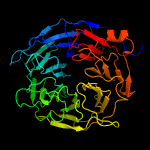Megf8 also known as Multiple Epidermal Growth Factor-like Domains 8, is a protein coding gene that encodes a single pass membrane protein, known to participate in developmental regulation and cellular communication. [5] It is located on chromosome 19 at the 49th open reading frame in humans (19q13.2). [6] There are two isoform constructs known for MEGF8, which differ by a 67 amino acid indel. The isoform 2 splice version (analyzed throughout this page) is 2785 amino acids long, and predicted to be 296.6 kdal in mass. Isoform 1 is composed of 2845 amino acids and predicted to weigh 303.1 kdal. Using BLAST searches, orthologs were found primarily in mammals, but MEGF8 is also conserved in invertebrates and fishes, and rarely in birds, reptiles, and amphibians. A notably important paralog to multiple epidermal growth factor-like domains 8 is ATRNL1 (Attractin-like 1), which is also a single pass transmembrane protein, with several of the same key features and motifs as MEGF8, as indicated by Simple Modular Architecture Research Tool [7] (SMART) which is hosted by the European Molecular Biology Laboratory located in Heidelberg, Germany. MEGF8 has been predicted to be a key player in several developmental processes, such as left-right patterning and limb formation. Currently, researchers have found MEGF8 SNP mutations to be the cause of Carpenter syndrome subtype 2.
Contents
- Gene
- Evolution & Orthologs
- Paralogs
- Promoters
- Transcription Factors
- Protein Architecture
- Primary Structure
- Secondary Structure
- Predicted Key Domains & Features
- Tertiary Structure
- Expression
- Function and Mechanisms in Cellular Processes
- Alternative Splicing, Mutations, & Phenotypic Impacts
- Splice Variants
- Common Mutations
- Current Research
- References
- Further reading








